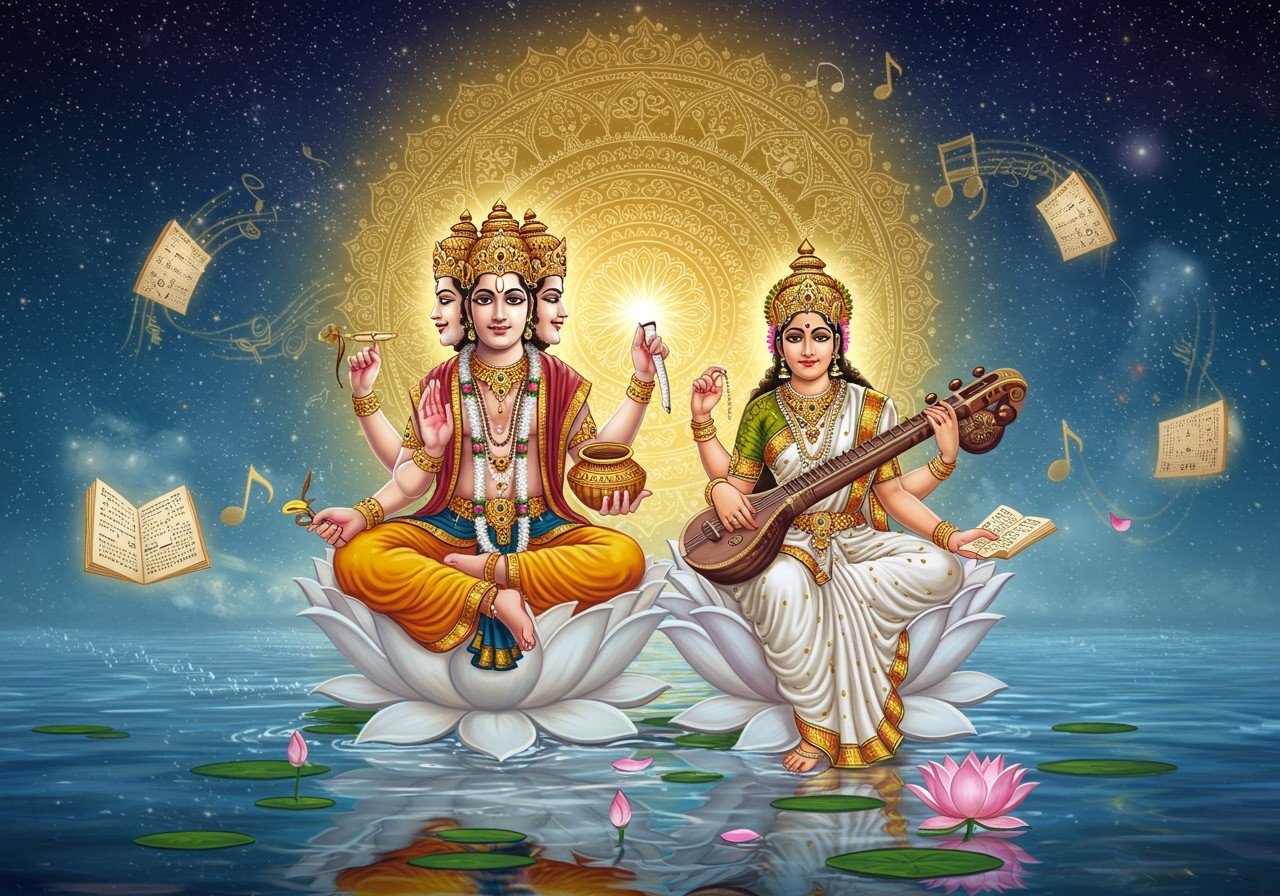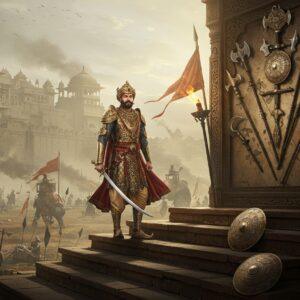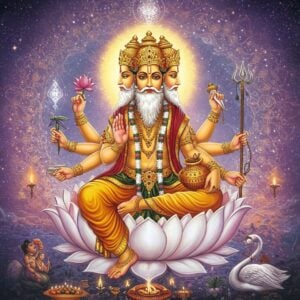
In Hindu mythology, Brahma and Saraswati hold significant roles as divine figures. Brahma is revered as the creator of the universe, while Saraswati embodies wisdom, knowledge, and the arts. Their stories reflect deep cultural values and influence various Hindu practices. Exploring their relationship offers insights into themes of creation, knowledge, and the arts.
The Role of Brahma in Hindu Cosmology
Brahma is one of the principal deities in Hinduism, forming the Trimurti with Vishnu the preserver and Shiva the destroyer. As the creator, Brahma is responsible for the formation of the universe. His depiction in sacred texts like the Vedas and Puranas highlights his importance. Brahma’s four faces symbolize his ability to see in all directions, representing omnipresence and omniscience. This creative aspect is central to understanding his role in Hindu cosmology.
Saraswati: The Goddess of Wisdom and the Arts
Saraswati is honored as the goddess of knowledge, music, arts, and learning. She plays a crucial role in Hindu culture, especially in education and creative pursuits. Her iconography often includes a veena (a stringed instrument), a book, and a swan, each symbolizing different aspects of learning, creativity, and purity. The festival of Vasant Panchami, celebrated in January/February, is dedicated to her and highlights her contributions to education and the arts. Saraswati continues to inspire scholars, musicians, and artists to this day. You can find items related to Saraswati Puja and Vasant Panchami at this link.
The Complex Relationship Between Brahma and Saraswati
The relationship between Brahma and Saraswati is multifaceted and complex, often depicted as both father-daughter and consort, depending on the specific Purana. Some texts refer to her as his daughter while others consider her his wife, or both. Mythological narratives describe their union as a balance between creation and knowledge. This divine relationship symbolizes the harmonious interplay of creative power and wisdom, reflected in Hindu rituals related to learning and art. Their stories emphasize the interconnectedness of creation and knowledge and the importance of divine inspiration in bringing forth the universe.
Delving into the Myths: Why Brahma Married Saraswati
Brahma’s marriage to Saraswati has mythological explanations rooted in the concepts of creation and knowledge. The narrative suggests that Brahma’s desire for understanding and wisdom led him to unite with Saraswati, who embodied these qualities. This union represents the necessary balance for universal continuity and evolution. Philosophically, their marriage symbolizes the harmony between the material and spiritual realms, reflecting the broader themes found in Hindu cosmology. It underscores the idea that creation cannot exist without the underlying principles of wisdom and knowledge.
The Enduring Legacy of Brahma and Saraswati
The mythology of Brahma and Saraswati continues to influence Indian culture and spirituality. Their stories are depicted in art, literature, and temple architecture across India. Various regional traditions have adapted these narratives, showcasing their enduring impact on religious beliefs and artistic expression. In contemporary Hindu practices, they play significant roles in educational ceremonies and artistic pursuits. Their tales remain relevant in discussions on creativity, innovation, and the pursuit of knowledge in the modern world.
Relationships between Brahma and Saraswati: Different Perspectives
The mythology surrounding Brahma and Saraswati is complex and varies across different Puranas. Understanding these variations offers a deeper insight into the evolution of these narratives and their diverse interpretations.
-
Daughter: Some Puranas, such as the Brahma Purana, Padma Purana, Brahmanda Purana, and Skanda Purana, portray Saraswati as the mind-born daughter (manasa putri) of Brahma. In this version, she is considered a virgin goddess without a spouse. The Matsya Purana describes Brahma meditating to create the universe, causing his body to split into male and female halves, with Saraswati emerging as the female half. This narrative highlights Saraswati’s independent nature and divine origin.
-
Consort: Other texts, including the Brahma Vaivarta Purana, Devi Bhagavata Purana, Lalitopakhyana, and some chapters of Skanda Purana, primarily depict Saraswati as Brahma’s consort. One account narrates Saraswati’s creation from Sri Krishna’s tongue, initially given to Vishnu. After a quarrel with Ganga, Vishnu transferred Saraswati to Brahma. This version emphasizes the role of Saraswati as a divine companion and partner to Brahma.
-
Daughter and Consort: The Matsya Purana and Bhagavata Purana present a combined perspective, portraying Saraswati as both daughter and consort of Brahma. The Matsya Purana describes Saraswati emerging from Brahma’s left side to assist in creation. Captivated by her beauty, Brahma grew multiple heads to gaze at her. Despite initial reluctance, she consented to be his spouse, residing in a lotus temple for a hundred divine years, which resulted in the birth of Svayambhuva Manu, the first mortal human. This narrative reflects the complex dynamics of their relationship and the symbolic significance of their union.
Saraswati’s Role and Significance: Beyond Brahma
Saraswati’s significance extends beyond her relationship with Brahma. She holds independent importance as a powerful goddess with diverse attributes and influence. Her worship is widespread and deeply ingrained in various religious traditions.
-
Goddess of Knowledge and Creation: Saraswati is revered as the goddess of knowledge, education, learning, arts, speech, poetry, music, purification, language, and culture. She is a pan-Indian deity, venerated not only in Hinduism but also in Jainism and Buddhism. This widespread reverence speaks to her universal appeal as a source of wisdom and inspiration.
-
Brahma’s Shakti: Whether as consort or creation, Saraswati is linked to Brahma’s creative power (Shakti). She embodies the intellect, wisdom, and creative energy necessary for the manifestation of the universe. This aspect highlights the essential role of wisdom and knowledge in the act of creation.
-
The Tongue of Vishnu: In some narratives where Saraswati is not depicted as Vishnu’s wife, she gains prominence as “the tongue of Vishnu.” This symbolizes her association with eloquent speech, poetic expression, and the dissemination of divine knowledge. It emphasizes her power of communication and her role as a medium for divine wisdom.
You can explore products related to Saraswati Puja on Poojn.in. They offer a range of puja items, including Saraswati Puja Dashakarma Kit, Saraswati Puja Dashakarma Kit for Murti Puja, and various other items for your puja needs.
Brahma’s Infatuation: A Tale of Desire and Consequences
The story of Brahma’s infatuation with Saraswati is a significant narrative exploring themes of desire, ethical boundaries, and the consequences of uncontrolled passions.
-
Captivation and Pursuit: Brahma was captivated by Saraswati’s beauty and intelligence. Some legends describe Saraswati’s attempts to escape Brahma’s gaze, leading him to grow additional heads to keep her in sight. This myth reflects the power of desire and its potential to cloud judgment. He developed heads in every direction, ultimately having five, to see her no matter where she went.
-
Incestuous Desire and Saraswati’s Resistance: Driven by incestuous desire, Brahma wanted Saraswati as his consort. Saraswati was horrified by Brahma’s intentions and sought to hide from him by transforming into various animals. This act of resistance highlights Saraswati’s agency and her refusal to succumb to Brahma’s inappropriate advances.
-
The Curse and its Implications: Saraswati cursed Brahma, decreeing that, unlike Vishnu and Shiva, he would not be widely worshipped on Earth. This curse is a significant element in Hindu mythology, explaining the relative scarcity of temples dedicated to Brahma. It emphasizes the importance of respecting boundaries and the consequences of violating ethical principles.
Symbolism and Allegory: Deeper Meanings Within the Myths
The stories of Brahma and Saraswati are rich with symbolism and allegorical meaning. These deeper interpretations offer insights into the philosophical and spiritual concepts embedded within Hindu mythology.
-
Knowledge from Creation: Saraswati emerging from Brahma symbolizes knowledge arising from the process of creation. It suggests that creation inherently gives birth to knowledge and understanding. This emphasizes the interconnectedness between the act of creation and the emergence of consciousness.
-
Inseparability of Creation and Knowledge: Their relationship represents the inseparability of creation and knowledge. Creation is impossible without knowledge, and knowledge is purposeless without creation. This emphasizes the symbiotic relationship between these two fundamental concepts.
-
Wisdom in Creation and Ethical Behavior: Brahma’s initial attraction to Saraswati reflects how creation cannot occur without wisdom. The subsequent renunciation of his attachment highlights the importance of self-control and ethical behavior. This narrative teaches the value of temperance and the necessity of aligning creative endeavors with ethical principles.
Conclusion: Embracing the Legacy of Wisdom and Creativity
The stories of Brahma and Saraswati weave a rich tapestry of wisdom, creativity, and ethical conduct. They illuminate the profound connection between creation and knowledge, emphasizing that one cannot exist meaningfully without the other. Through their myths, we learn the importance of wisdom in all endeavors and the necessity of ethical behavior in the pursuit of knowledge. As we explore these tales, we draw inspiration from the cultural practices and spiritual understandings they have shaped over centuries. Brahma and Saraswati continue to guide us, encouraging reflection on our own values and actions. By honoring these traditions, we embrace a legacy of wisdom and creativity that enriches our lives and inspires us to strive for balance and harmony in our creative pursuits. Explore our collection of puja items at poojn.in to enhance your spiritual journey.


